#Sambucus canadensis
Photo

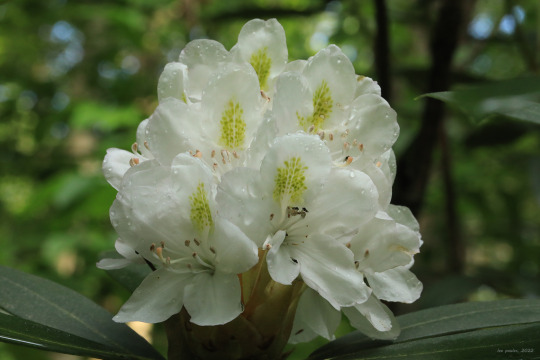
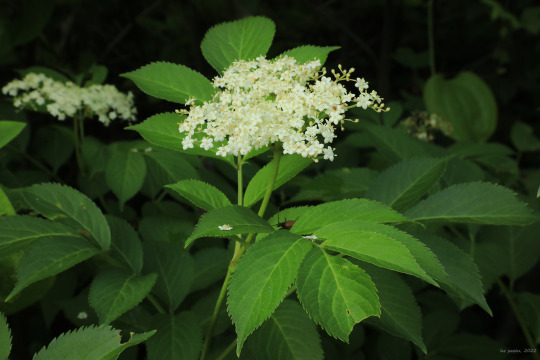

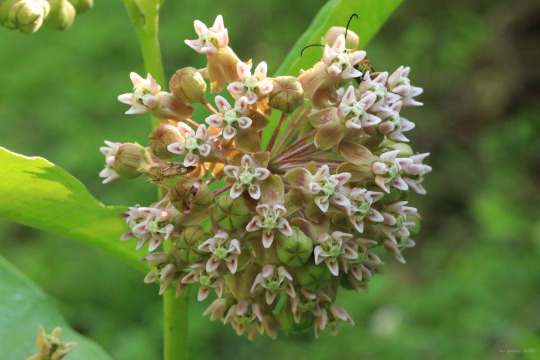





Above are a few photos from a late afternoon hike in the Cheat River Canyon, just after a line of heavy thunderstorms moved through the area. The storms were still brewing at the southern end of the canyon near Albright when I reached the overlook area. Great rhododendron (Rhododendron maximum) is starting to bloom in the canyon, but the real show is probably a week away. Milkweed is also coming on strong, with three varieties growing in the open fields and clearings around the canyon - poke milkweed (Asclepias exaltata), common milkweed (A. syriaca), and butterfly milkweed (A. tuberosa). I once heard milkweed described as a “mega-supermarket for insects”. It’s true. If you want a good starter course on the insects native to your region, then cozy up to the nearest milkweed plant in bloom with an insect field guide in hand.
From top: great rhododendron, also known as great laurel and rosebay rhododendron; American black elderberry, also known a American black elder (Sambucus canadensis), whose purple-blue berries will soon be used by locals to make wine, jam, jellies, and pies; common milkweed, which draws insects, including the banded longhorn beetle (Typocerus velutinus), in droves; butterfly milkweed, also known as butterfly weed; poke milkweed; eastern teaberry (Gaultheria procumbens), whose edible berries and leaves are used to flavor everything from tea to ice cream; and the adorable shinleaf (Pyrola elliptica), also known as waxflower, a shade-tolerant perennial of moist woods.
#appalachia#vandalia#west virginia#summer#flora#wildflowers#insects#cheat river canyon#cheat canyon#chestnut ridge#snake hill wildlife management area#rhododendron maximum#great rhododendron#great laurel#rosebay rhododendron#sambucus canadensis#american black elderberry#american black elder#asclepias syriaca#common milkweed#typocerus velutinus#banded longhorn beetle#asclepias tuberosa#butterfly milkweed#butterfly weed#asclepias exaltata#poke milkweed#gaultheria procumbens#eastern teaberry#pyrola elliptica
100 notes
·
View notes
Text
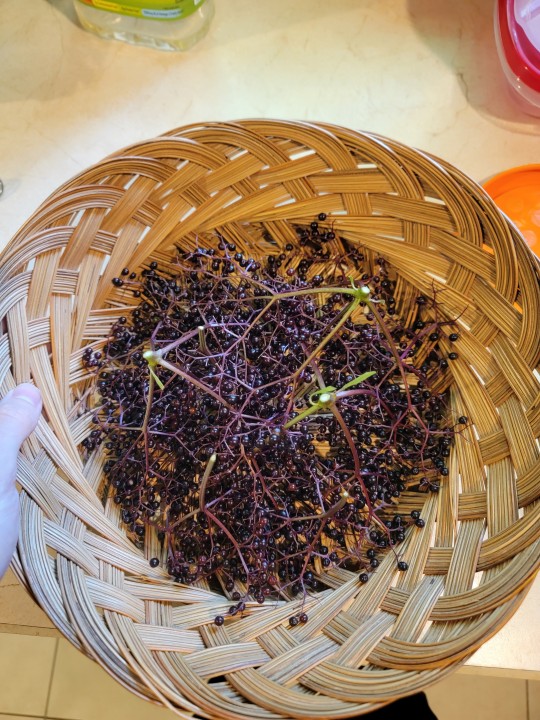
Hey Everyone, I mentioned a few months ago in my elderflower tea post that it's best to wait for the berries and now it's time for Elderberry Syrup! Mid to Late Summer is typically the time to find ripe elderberries, the only edible kind are the ripe black elders discard the green berries. In the eastern US that's most likely gonna be S. Canadensis. I'm going to go through the process of cleaning and preparing to make syrups.
You'll need:
A strainer
A potato masher or like crushing implement
2 tablespoons of honey per cup of whole berries
Elderberries fresh
2-3 cups of Water per cup of berry
First thing to do is to find an elderberry bush, if you search my tags for 'Elderberry' or 'Sambucus Canadensis' you will see how to identify the plant through leaves. Right now fruit should be hanging heavy off the shrub, feel free to cut the ends of berry bunches off the steam to gather berries in a bowl or basket.

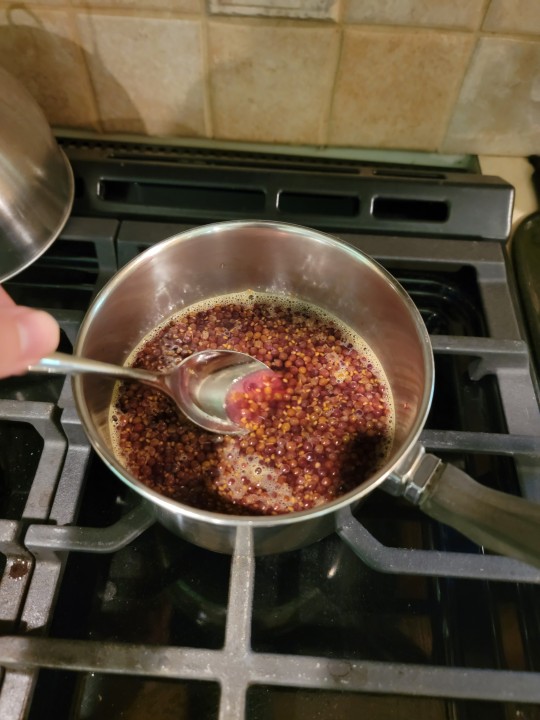
First go through the effort of removing the berries from the stems, remove as many stems as you can as they contain poisons if consumed in high quantities (they should be easy to remove). If you struggle with hand dexterity i recommend using a hair pick or a fork to pull the berries off the umbel. Be sure to rinse the berries often, there will be some little spiders. Once rinsed, place the berries in a pot and start mashing with the potato masher then pour your water. Seeds should float to the top, for convenience/propagation purposes you can remove them but removing them from the pan in not necessary, cooking will kill the toxic potential of the seeds as long as they are not consumer directly (we'll strain them out at the end). Bring the berries and liquid to a boil and then simmer for 45 minutes until reduced.

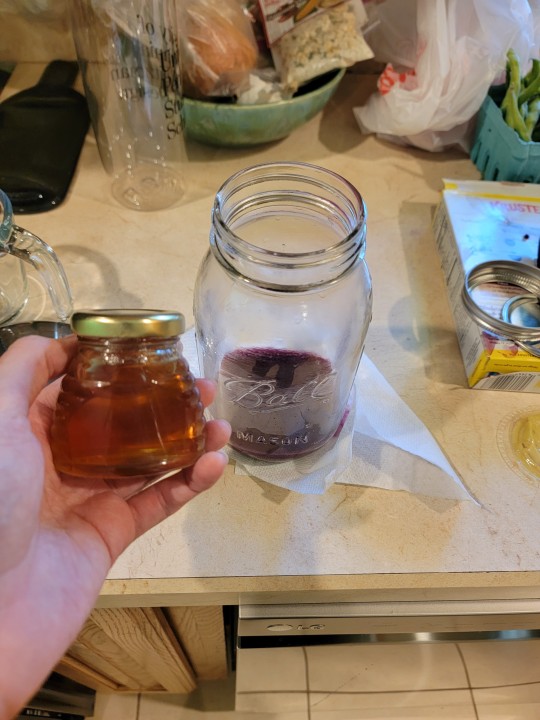
Once reduced place a strainer over a container and pour the berries over, use a spoon to press additional juices from the mixture, remove any seeds which may have fallen in.
Next we should add honey to the elder syrup as the flavor is vastly improved (and less bad) with the addition of honey. Mix vigorously.
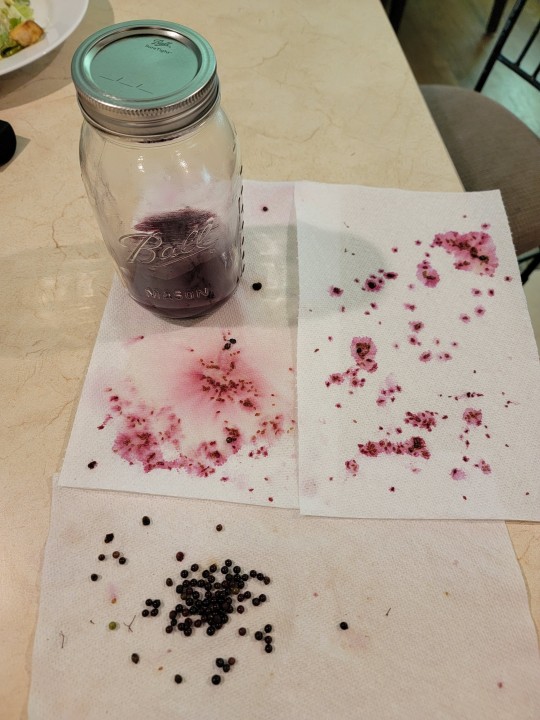
Finally you should have about 1/2 cup of syrup per 1 cup of solid berries. As seen in the image below you'll also have a bunch of seeds, I recommend spreading these on moist soils if elders are native to your region. You'll also have a wonderful syrup flavour to add to seltzers and spritzers
[EDIT] use this fresh it did not store very well
7 notes
·
View notes
Photo

The dramatic Elderberry .. [2 / 2]
Stolidly imposing trunk of Sambucus canadensis, on the riverfront Point State Park, Pittsburgh, PA.
Notice how you can make out the shape and structure of the bark lower down, but higher up as the tree ascends into the sky, the contrast grows to becoming an almost stylized fractal structure. That's because this was a panorama swept up, and the camera internally compensated for the brighter sky and still stitched the picture together into one whole. It is not dissimilar to how our eyes work, so captured the right look by accidental HDR. All hail computational photography.
#iPhone#iPhone13Pro#panorama#botanical#Pittsburgh#Pennsylvania#USA#Elderberry#Sambucus canadensis#HDR
3 notes
·
View notes
Text




#tree#spring#flowers#plants#nature#american elderberry tree#sambucus canadensis#elderberry#elderberries#front yard#natural occurrence#spring aesthetic#white flowers#naturalhealing
13 notes
·
View notes
Photo
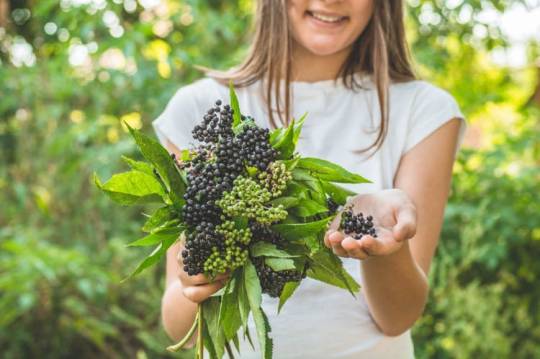
SUPERFOOD - Organic Elderberry Seeds Blend - Heirloom Seeds for The Gardener & Rare Seeds Collector B25 Elderberry Seeds - Seeds to Plant - Sambucus Canadensis - Non-GMO Seeds Elderberry is a bushy, multi-stemmed, wide-spreading shrub or small tree with deciduous compound leaves. It typically grows 10-15 feet tall with a similar spread. The leaves of the American elder are opposite, pinnately compound (featherlike), and up to a foot long. Large, terminal, flat-topped clusters of fragrant, tiny star-shaped white flowers arranged in showy sprays up to 10 inches across appear in spring. The flowers are followed by clusters of shiny dark purple to black, berry-like fruits (drupes) in late summer to fall. Fruit may be used to make preserves, jellies, and pies. Fruit is also attractive to wildlife. In the fall, elderberries put on a colorful display of yellows, oranges, and reds. This Elderberry not only delights with beautiful blooms and delicious berries but provides multi-seasonal interest with foliage that changes to red-orange in the fall months. Attract wildlife and gain the nutrients of Elderberries with this stunning shrub! This Elderberry is not self-pollinating, so we recommend planting with the Wild Elderberry for best pollination. (Sambucus canadensis) Elderberry is well known as an ingredient in pies and jams but now the medicinal world has reported the use of elderberry helps mitigate colds and flu viruses because of its antiviral properties. It is also a great source of vitamin C and has been used for antibacterial properties as well. These elderberry seeds will produce trees that give berries that are rich in anthocyanins, bioflavonoids, vitamins, and antioxidants. Perennial, deciduous, multi-stemmed bush to small tree. The berries are very tasty, and about twice as big as the berries of other species.Hardy to -30 degrees F. Sambucus Nigra, commonly known as Elderberry, is a large 4-6 m tall shrub and grows at a fast rate. Elderberry is known for its fragrant, flat-topped, cream flowers that are followed by abundant, edible purple-black berries in September. The flowers are hermaphrodite. The shrub is an attractor of beneficial insects and hummingbirds. Sambucus nigra occurs naturally across western North America from Canada to Mexico. Elderberry can be used as a windbreak or a living fence. The edible berries are commonly cooked, dried, or used in jams, jellies, pies or preserves. The fruit is also often used to make wine. The flowers are also edible. You can eat them either fresh or cooked. They are popular when covered in batter and fried into fritters. They can be pickled if picked when unopened. Also, fresh flowers can be soaked in water to make a refreshing drink. A sweet tea is made from the dried flowers. Count: ~25 seeds American Elderberry Seeds - Sambucus canadensis EDIBLE FRUIT - Edible Hedge Shrub With Fruits - FRAGRANT EDIBLE FLOWERS Zones 3 - 9 These seeds are from a Northern range collection which is more cold-hardy than the Southern range collection Heirloom, Non-GMO seeds for planting with the high germination rate Huge flat clusters of tiny white flowers are followed by a heavy crop of shiny black fruit This is an easy to grow that makes a nice large informal screen or hedge or can even be pruned into a small tree form Elderberry is often used to make syrup, jelly, wine, and more EXOTIC AND RARE GARDEN SEEDS: Great gift for mom, dad, gardener, Great outdoor STEM Project for Kids FUN AND EASY: EDIBLE FRUIT - Edible Hedge Shrub With Fruits - FRAGRANT EDIBLE FLOWERS You've got to try it for yourself The native shrub grows 10-15 ft. tall Produces clusters of berries high in antioxidants For best fruit production, plant two different varieties Attract Butterflies Attracts Bees/Butterflies/Birds Pollinators / Bee Friendly Deer/Rabbit Resistant Native Flower / Foliage For Cut Flowers Edible Good For Erosion Control / Windbreaker / Hedge / Screen Does Not Require Support / Long-Lived Open-Pollinated Requires Summer Water Shade Tolerant Useful in Dye Making NAME: Elderberry SCIENTIFIC NAME: Sambucus Nigra Canadensis COLOR: White PLANT SEEDS: Fall / Cold Stratify PLANT HEIGHT: 8 - 10’ PLANT SPACING: 8 - 10’ BLOOM TIME: Late Spring - Early Summer HARDINESS ZONE: 3 - 10 LIGHT REQUIREMENTS: Sun / Half Shade SOIL & WATER PREFERENCES: Average - Moist - Wet Approximate Harvest Time: Late Fall Soil pH : 6.1 - 6.5 The Elderberry’s flowers are fragrant and smell like honey. It attracts birds, bees, and butterflies. The birds love to eat its ¼” juicy berries, The berries are also edible by humans if they are ripe & fully cooked. Otherwise, they can be poisonous. This shrub has interesting bark and is also used as a medicinal herb. Germinating Elderberry Seeds – Elderberry Seed Growing Tips Germinating Elderberry Seeds Elderberry seeds have a thick, tough seed coat and what botanists call “natural dormancy.” This means that the seeds must obtain optimal conditions before waking up from their deep sleep. In the case of elderberries, the seeds must be stratified twice. This is not difficult, but it takes time, up to seven months to complete. The stratification required to start propagating elderberry from seed should mimic nature’s cycle. First, expose seeds to warm conditions– like the normal conditions found indoors– for several months. This is followed by winter temperatures for another three months. Experts suggest you mix the seeds into a well-draining substrate like a mixture of compost and sharp sand. This should be moist but not wet and there should be enough to keep the seeds apart from one another. Put the mixture and seeds into a large zip-lock bag and let it sit somewhere with temperatures of around 68 degrees F. (20 C.) for 10 to 12 weeks. After that, place it in the refrigerator at 39 degrees F. (4 C.) for 14 to 16 weeks. At this point, the seeds can be sown in an outdoor seedbed, keep moist and wait for the seedlings to appear. After a year or two, move them to their final location. It is vital that they are soaked to help the sprouting process. Understand that these are "small" tree seeds. Not all would be 100% viable, it is just the chance you take. When soaking the seeds, the ones that float after about 8 hours should be removed. They most likely will live, but chances are low. Only use the seeds that sank to the bottom. It is vital to use seed starting pods. It is a must!! Place about two seeds in each pod, make sure to keep these moist and warm while germinating. They do take some time to germinate. Have patience and you will be rewarded. They love direct sunlight when germinating. After some time, when they become healthy and large enough, you may then transplant them. Understand that you must keep your eye on these so that you have healthy trees in the long run. You can put them in warm water and let them soak for about 30 hours. You can also surface sow them, use a grow lamp or sun for more than 6 hours, and mist twice a day. It may take about 10 days to sprout. These statements have not been evaluated by the Food and Drug Administration. This product is not intended to diagnose, treat, cure, or prevent any disease. http://springsofeden.myshopify.com/products/superfood-organic-elderberry-seeds-blend-heirloom-seeds-for-the-gardener-rare-seeds-collector-b25
#Sambucus nigra#Sambucus Canadensis#European elderberry#York Elderberry#Adams Elderberry#European Red#Lemon Lace#Black Beauty#American Elderberry#Organic Seeds#Heirloom Seeds#Black Lace
0 notes
Text
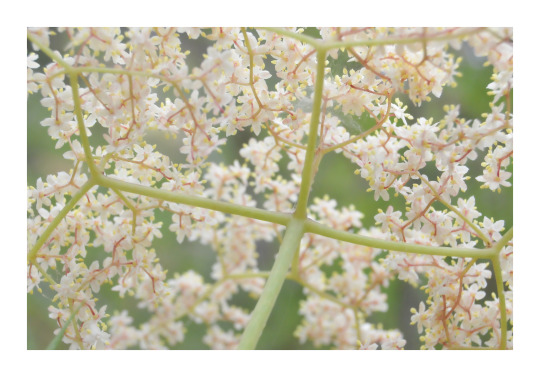
Untitled.
#photographers on tumblr#American black elderberry#Mexican elder#Sambucus nigra canadensis#Miller Canyon#Coronado National Forest#Cochise County#Arizona
71 notes
·
View notes
Text

Sambucus Canadensis..elderberry..
175 notes
·
View notes
Text
More flowers from my garden!
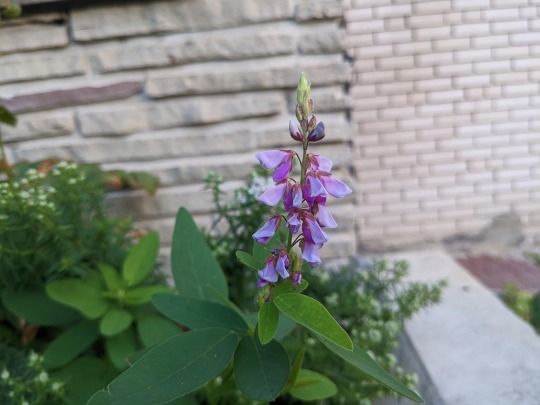
Desmodium canadense (showy tick trefoil)
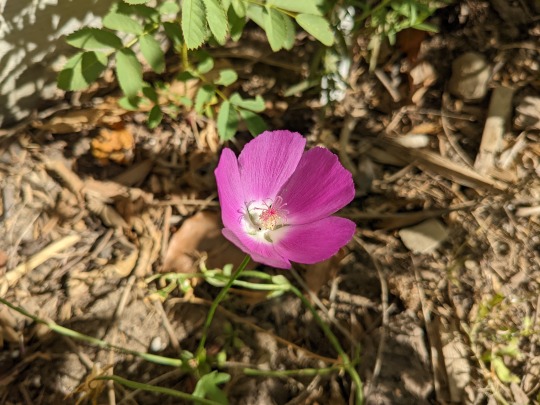
Callirhoe involucrata (purple poppymallow)

Pycnanthemum virginianum (Virginia mountain mint)
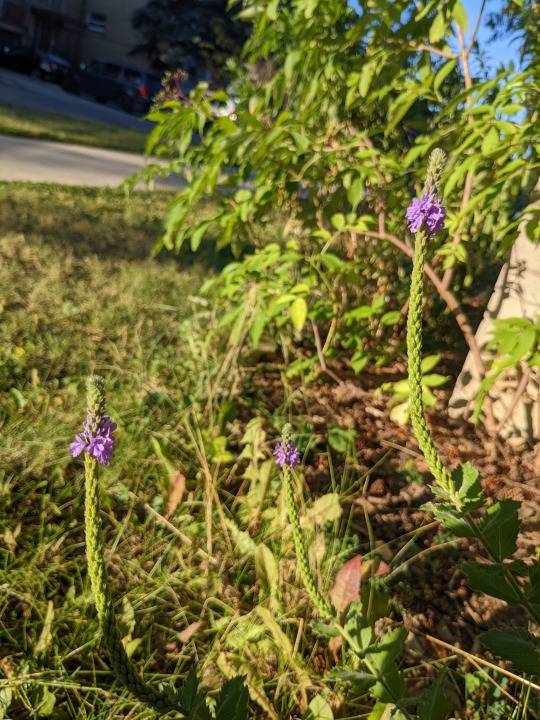
Verbena stricta (hoary vervain)

Eupatorium purpureum (sweet joe-pye-weed)

Monarda punctata (spotted beebalm)
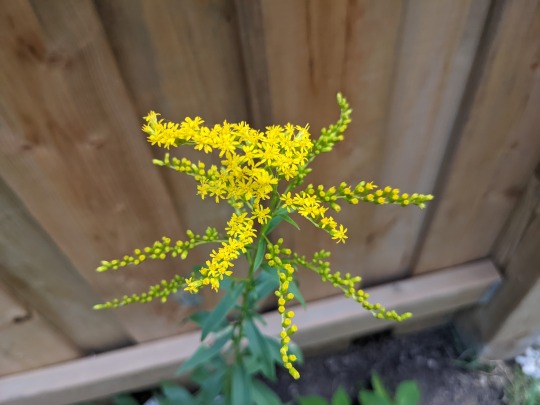
Solidago juncea (early goldenrod)
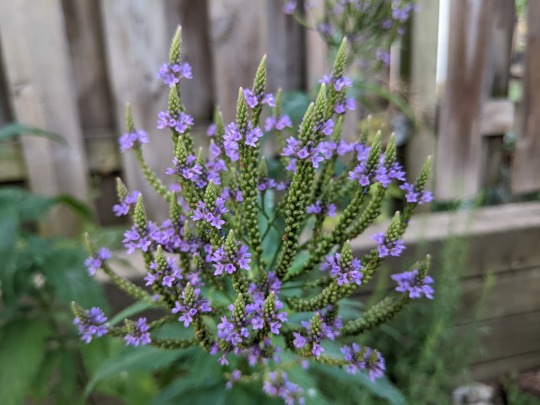
Verbena hastata (blue vervain)
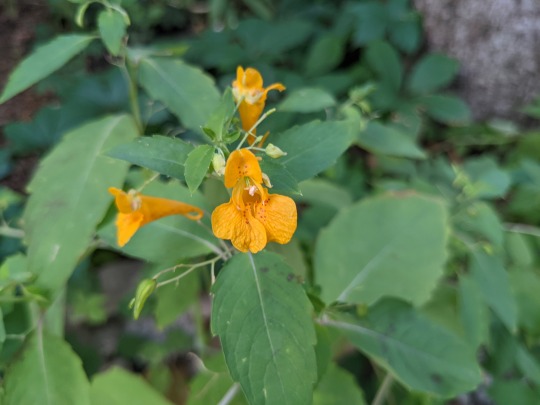
Impatiens capensis (spotted jewelweed)

Helianthus nuttallii (common tall sunflower)

Symphyotrichum ciliatum (fringed blue aster)
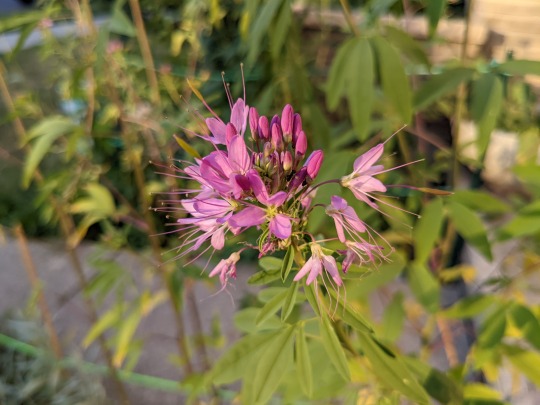
Cleome serrulata (Rocky Mountains bee plant)

Actaea racemosa (black snakeroot)

Helianthus pauciflorus (stiff sunflower)
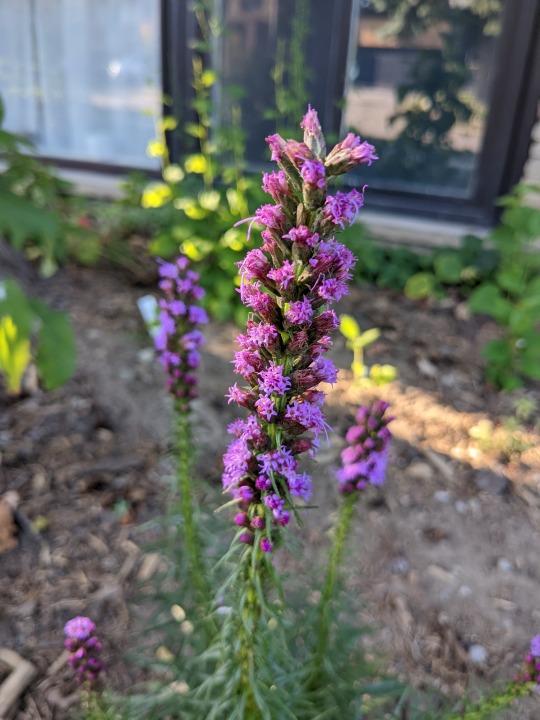
Liatris spicata (dense blazing star)

Hypericum punctatum (spotted St. John's wort)

Spiraea alba (meadowsweet)
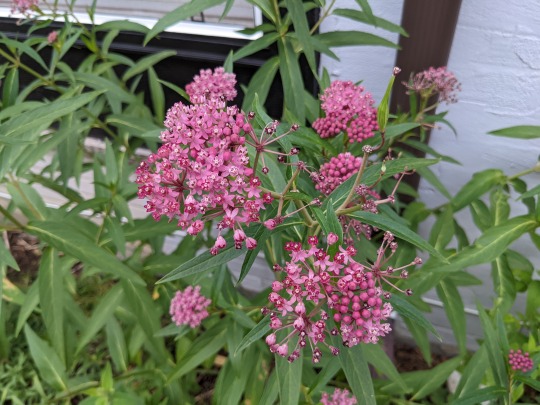
Asclepias incarnata (swamp milkweed)

Agastache foeniculum (anise hyssop)
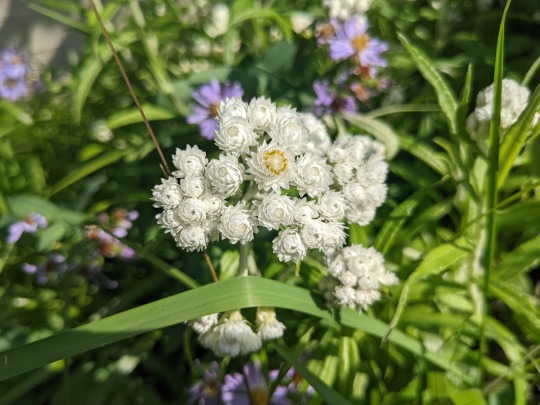
Anaphalis margaritacea (pearly everlasting)

Symphyotrichum laeve (smooth aster)
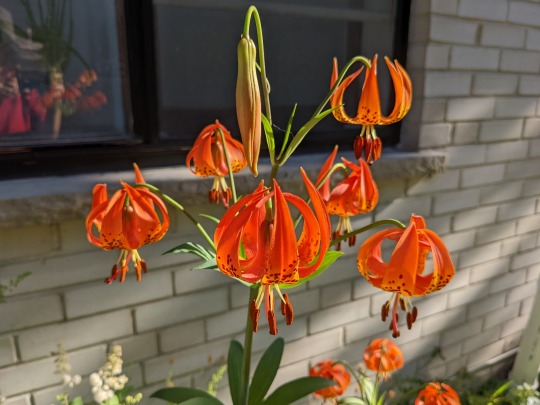
Lilium michiganense (Michigan lily)
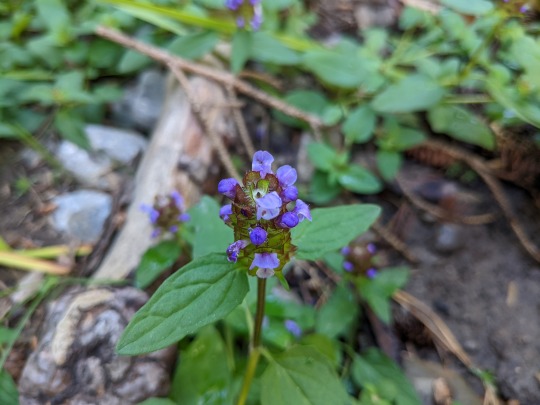
Prunella vulgaris ssp. vulgaris (common selfheal)

Symphyotrichum lanceolate (panicled aster)

Astragalus canadensis (Canada milk vetch)
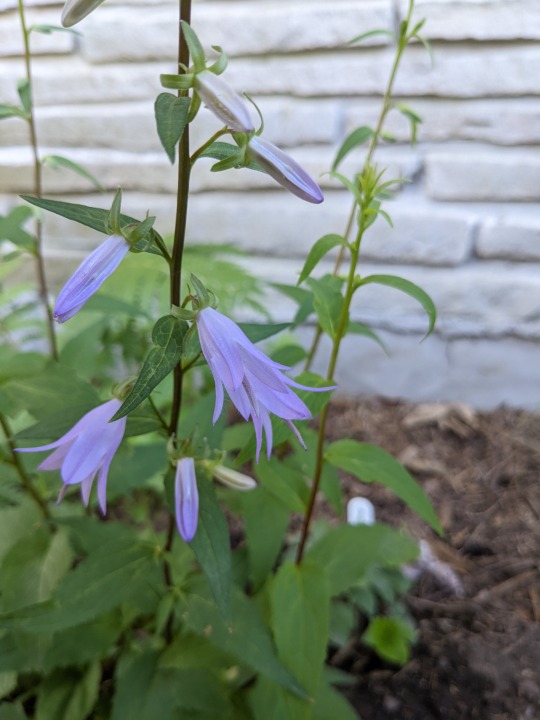
Campanulastrum americanum (marsh harebell)

Sambucus canadensis (common elderberry)

Mertensia paniculata (tall bluebells)
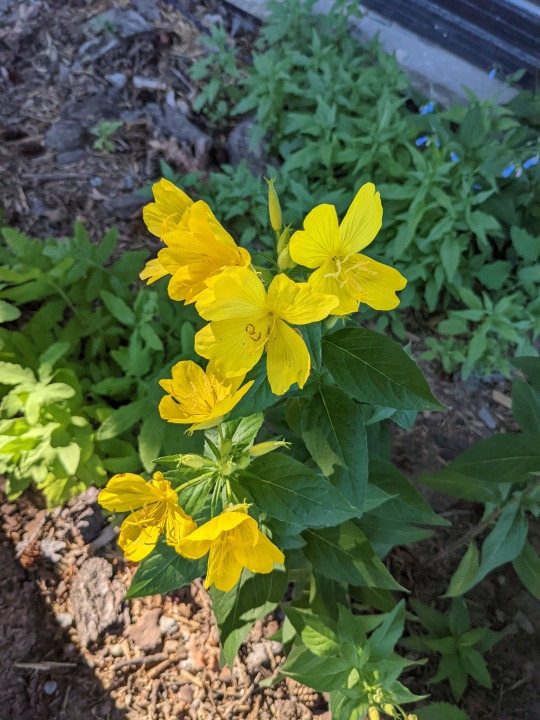
Oenothera fruticosa (narrow-leaved sundrops)

Lilium philadelphicum (wood lily)
And cut off again. lol
16 notes
·
View notes
Text
I’ve got big plans for the front yard. While I’m going to leave some lawn* in the backyard, the front will eventually be completely planted. First, I’m planting a mixed hedge along the foundation. I’m still deciding the exact mix of shrubs for the hedge but I’m currently thinking elderberry (Sambucus canadensis), rough dogwood (Cornus drummondii), American hazelnut (Corylus americana), prairie rose (Rosa arkansana), and maybe chokecherry (Prunus virginiana) or American plum (Prunus americana). Both chokecherry and American plum make me nervous because they tend to get really wide through suckers which might be too much for the area. I’m planting the shrubs half the maximum mature width away from a 3 ft wide pathway around the foundation to hopefully prevent any branches or roots touching the siding or foundation and to allow us to service the utilities in the area.
*By lawn, I mean stuff that looks mostly like grass and stays under 6” tall or can be mowed. I’m going to overseed the existing patchy turf with clover (Trifolium repens) and maybe some tiny native flowers if I can get my hands on some seeds. I’m specifically thinking about fetid marigold (Dyssodia paposa) and curlycup gumweed (Grindelia squarrosa).
7 notes
·
View notes
Note
Hello there, I was combing through your posts regarding Elder and I was wondering, do you feel there is a distinction between the different species of Elder with regard to the Elder Mother? In your opinion, would one still be able to effectively: reach out to, leave offerings for, and potentially work with the Elder Mother through Black Lace Elder or Sambucus Canadensis? In your experience, does she govern all species of Elder or specifically only Sambucus Nigra? Does it matter all that much? Thank you very much and have a lovely day
I do firmly believe that the Elder Mother oversees all Sambucus trees. In fact, Elder is one of the scarce few trees I know of that grows natively in some part of every inhabited continent, which is part of what makes Her such a particularly powerful and far-reaching spirit. This reflects Her role as an Elder of the Gloaming (no pun intended) which, in the Wending Way, refers to the 'royalty' or 'gods' of the Faerie Folk.
Good question!
28 notes
·
View notes
Text
Neopronouns in action: it/its/itself
EX:
"It is going to adopt a new puppy soon, as soon as it gets a fence set up around its yard so the puppy can go outside without it having to walk it. Its uncle is going to help set up the fence, since he has a set of power tools he's letting it use, since it lost its."
This is also a free writing prompt!
===
The Interworld Growing Club
It was the first human to join the transworld growing club, and it brought Sambucus canadensis, Diospyros virginiana, Prunus caroliniana, and Passiflora incarnata seedlings with it as the four traditional gifts.
Each new member brought with them four species native to their planet that weren’t already included in the collective.
It wasn’t the first new member to join, or the only first of its species - on the same planetary cycle (defined by the system’s governing council as being forty-seven hours long), the first seyeir also joined, and zainun brought four species whose names the human couldn’t remember how to pronounce (and thus, remember) yet.
Most of the other members of the club had never met a human before, since they were still so new to having interstellar travel capabilities, so the pre-approved list of questions it was okay to ask almost got used up entirely.
How often did it need to sleep? What did it eat? How often did it need to eat? What did it drink? Did it eat the species it had brought with it? Were the species it had brought with it pets? Did it have any pets, and if it was safe, could they meet them?
How long did it need to sleep? Was it telepathic? Did it have any disabilities among its species? Could it smell their pheromones? Could it see their colors? Did it know what dreams were? Did it dream? Did it remember its dreams? Was this its first time leaving Earth? How many planets had it gone to? How many space stations had it gone to?
What was the spaceship it had come here in called? What was its favorite color? What was its favorite sound? Did it have a favorite time? What was its favorite food?
How many genders did humans have? What was its gender? What were its pronouns? If it was attracted to any genders, what kinds of genders was it attracted to, and how?
Would it be interested in courting an alien? Did humans lay eggs? Did humans reproduce by budding? How did it get its name? Did it have any siblings or parents or friends?
How long could it stand? How much weight could it lift? Did it take any medicines? What should they do if it was injured and couldn’t help itself? What should they do if it stopped breathing?
How long could it survive in the vacuum of space? What should they do if it was exposed to the vacuum? What should they do if it got too hot? What should they do if it got too cold?
What kinds of foods could it eat? Would it show them how humans cooked and ate the species it was gifting to the collective?
The last question would take a while to come to fruition, because the seedlings it had brought with it were still very small, and wouldn’t produce fruit for anywhere from a few months to several years. And the Prunus caroliniana wasn’t edible for humans, but the on-station medical experts had concluded that the fruits would be edible for several of the other member species, which was why it had chosen it as one of the gift species. The other three were edible for humans, and for half a dozen member species, each.
Three other members were delighted that it used it/its pronouns, just like they did, though they each described their genders very differently than it did.
Once the questions were done, it was led on a tour of the communal growing area, where, safely contained behind several layers of state-of-the-art forcefields, physical walls, airlocks, and other safeguards to prevent any escapes, all of the hundreds of species that had been gifted to the growing club were cultivated in a self-contained, self-sustaining, completely unique ecosystem.
Each new species was carefully integrated into the rest so that its outputs and inputs would work in a careful balance with the rest of the system, so that each species got what it needed, and gave what it didn’t. The species weren’t limited to what humans called plants, either, since most non-Earth species didn’t conform to anything that could easily be categorized within the normal Earth standards. What humans called plants, animals, and mushrooms were all involved, as well as hundreds of species human taxonomists hadn’t even begun to think about sorting.
The four species the human had brought with it would be given their place, once they were studied and understood by the club members who were most familiar with the system, and until then, they had much to teach the human, who was more than happy to learn, and ask its own questions.
#long post#neopronouns in action#neopronouns#writing prompts#neopronoun writing prompts#trans#transgender#nonbinary#xenogender#pronoun nonconforming#queer#mogai#pride#lgbt#ititspronouns#it/its#it/its/itself#science fiction#scifi#scifi writing prompts#science fiction writing prompts#aliens#alien farming#alien gardening#don't turn this into some stupid human-centric ''h*mans are sp*ce or*s'' bulshit.#censored so it doesn't show up in that stupid tag.#ectopronouns in action
9 notes
·
View notes
Photo

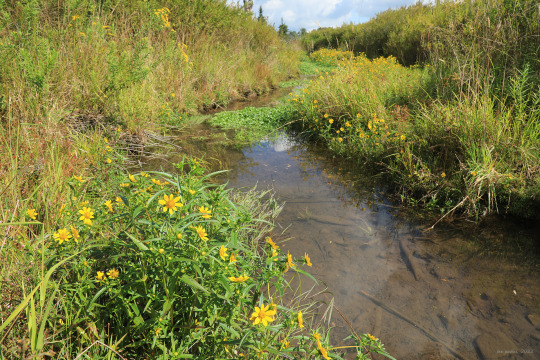

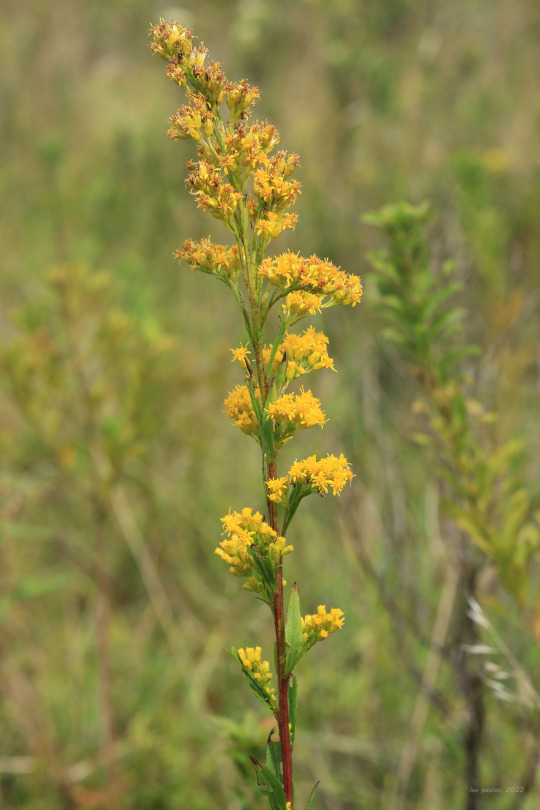


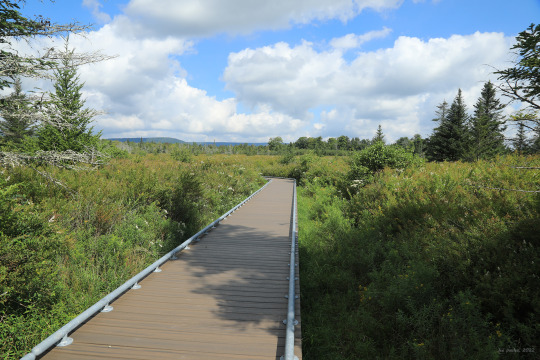

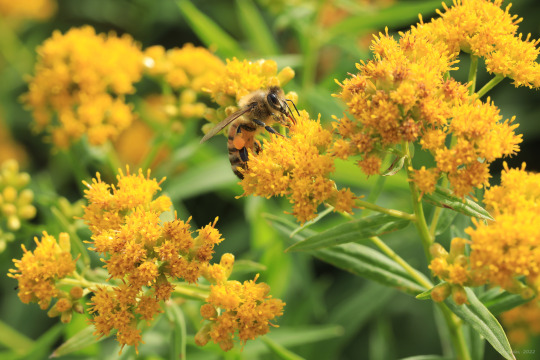

Canaan Valley National Wildlife Refuge, Part 3. Canaan Valley is the highest mountain valley of its size east of the Mississippi River and hosts the largest wetlands complex in the Central and Southern Appalachians. Most of these wetlands are now protected by Canaan Valley State Resort Park and Canaan Valley National Wildlife Refuge. The Freeland Boardwalk Trail in the refuge is an ideal place to get an up-close experience with one of the wetland types - a balsam fir swamp. A half-mile long, raised boardwalk with wildlife viewing platforms winds through the swamp, allowing visitors to interact with the wildlife and plants without damaging the fragile ecosystem.
From top: Bur marigold (Bidens laevis), also known as smooth beggartick, a wetlands-loving beauty that produces a profusion of golden flowerheads; bog goldenrod (Solidago uliginosa), another wetlands native with a bright red stem and closely-packed flowers on a plume-like inflorescence; the bright blue berries of arrowwood viburnum (Viburnum dentatum); the ripening berries of American black elderberry (Sambucus canadensis), also known as American black elder; white meadowsweet (Spiraea alba), a native spirea of Appalachia’s wetlands that draws hordes of pollinators with its beautiful spikes of white flowers; grass-leaved goldenrod (Euthamia graminifolia), also known as flat-top goldentop, not a true Solidago, but even more beautiful with its flat panicles of golden-yellow flowers and graceful foliage; and an industrious bumblebee prying open the closed petals of a narrowleaf gentian (Gentiana linearis) to get at the nectar pot below.
#appalachia#vandalia#west virginia#canaan valley#canaan valley national wildlife refuge#wetlands#balsam fir swamp#canaan fir#balsam fir#freeland boardwalk trail#bidens laevis#bur marigold#smooth beggartick#solidago uliginosa#bog goldenrod#viburnum dentatum#arrowwood viburnum#sambucus canadensis#american black elderberry#american black elder#spiraea alba#white meadowsweet#euthamia graminifolia#grass-leaved goldenrod#flat-top goldentop#gentiana linearis#narrowleaf gentian#narrow-leaved gentian#bumblebee#bombus
50 notes
·
View notes
Text


Wild Tea Recipe: Elderflower Tea
Sambucus Canadensis is the American elder, a large shrub often growing beautifully in streambanks, thickets, and disturbed lands. To identify American elder look for pointed pinnate ash-like leaves, white flowers in June or black berries in late summer like the images above. A word of caution; all parts except for the flowers and ripe berries are poisonous, be sure to remove any stems before brewing.
For this recipe we require only one umbel worth of florets from this lovely bush. I urge people to never take more than a small amount for a few reasons, you really don't need more, the elder in its native habitat has tremendous ecological value (it's hard to find a part of the flowers not crawling with life, see caterpillar in the image below), also you can get more cooking value out of the berries later on.
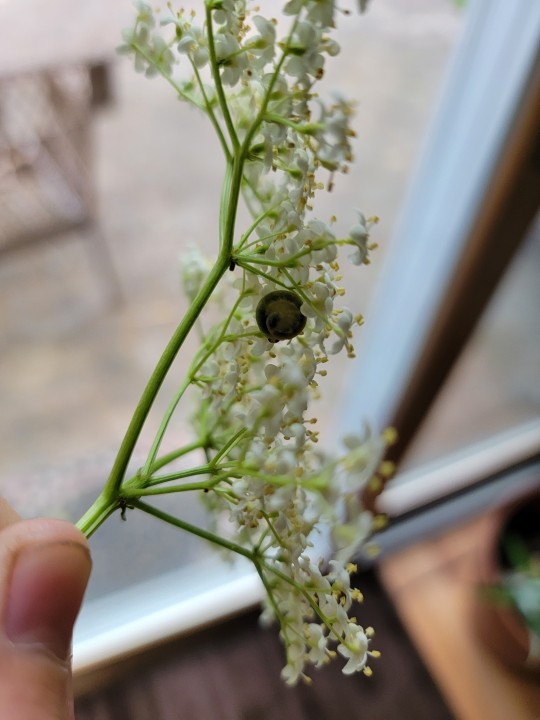
You should harvest the flowers in early morning before intense sun hits them, aside from improved flavor, the flowers smell much better before being exposed to sunlight. With that just start the process of pushing the florets off the stem, once separated like the image below begin rinsing them lightly to remove small insects (there's always some incredibly tiny thripes).
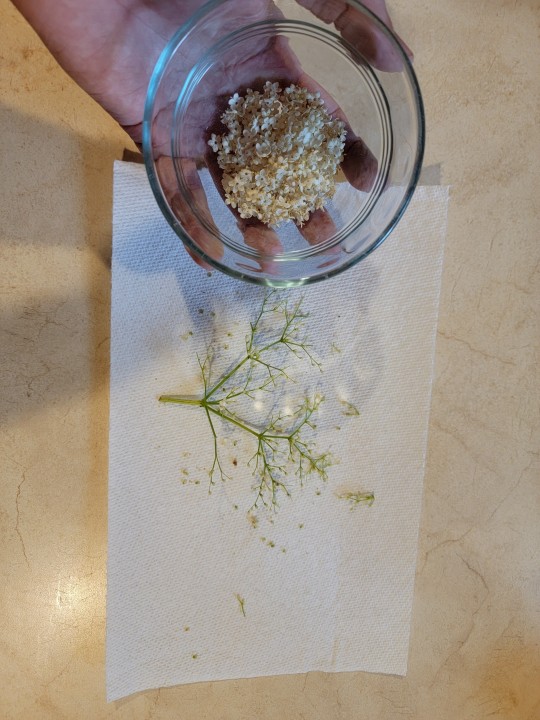
Once clean, place in a tea bag/reusable steeper and brew with boiling water like an herbal tea for 15-20 minutes. The smell is lightly floral, I find the pure taste is reminiscent of a light milk with a floral after taste.

Good hunting! Remember if you are unsure simply wait and observe your plant throughout the year if you can. I typically do not take from a habitat unless I am familiar with how I will affect it. Foraging native species without care can be incredibly destructive.
#american elders are rare where i live so I'm more careful I'm aware they are very common elsewhere#i have fewer sources so I'm more assertive about care#foragers#forage tea#native species of eastern america#elderflower#sambucus Canadensis
4 notes
·
View notes
Photo
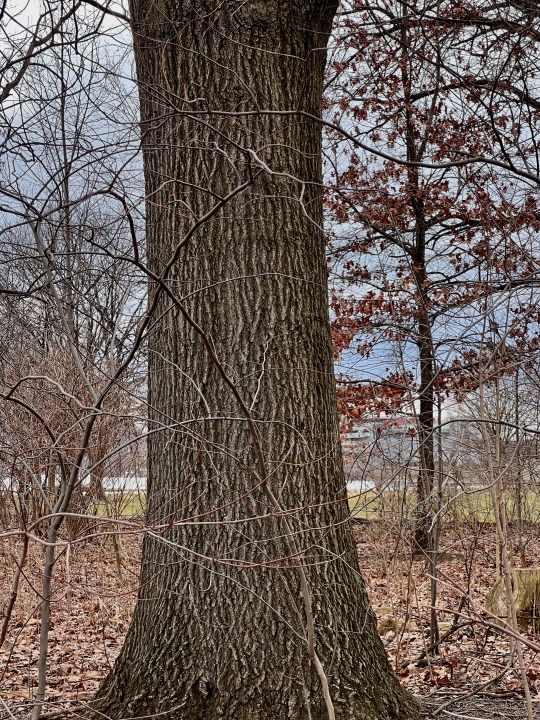
The hoary bark of an American Elderberry .. [1 / 2]
Stolidly imposing trunk of Sambucus canadensis ignores the whippersnappers all around it, on the riverfront Point State Park, Pittsburgh, PA.
0 notes
Text
Discover Quality American Elderberry Cuttings for Sale
Are you looking to enhance your garden with vibrant and healthy elderberry plants? Look no further! Our shop offers premium American elderberry cuttings for sale, perfect for planting and cultivating your very own elderberry bushes.
Why Choose American Elderberry Cuttings?
Native to North America: American elderberries (Sambucus canadensis) are native to North America, making them well-suited to various climates and soil conditions across the continent.
Health Benefits: Elderberries are known for their rich antioxidant content and potential health benefits. From immune support to anti-inflammatory properties, incorporating elderberries into your garden can provide both beauty and wellness.
Versatile Uses: Not only are elderberries great for health, but they're also versatile in culinary applications. You can use elderberries to make delicious jams, syrups, wines, and more, adding a flavorful touch to your homemade creations.
Easy to Grow: American elderberries are relatively easy to grow, making them an excellent choice for both experienced and novice gardeners. With proper care and maintenance, you can enjoy a bountiful harvest of elderberries in your own backyard.
Why Buy Elderberry Cuttings from Us?
Quality Assurance: We take pride in offering top-quality elderberry cuttings sourced from healthy and thriving plants. Each cutting is carefully selected to ensure viability and growth potential.
Expert Guidance: Whether you're new to gardening or a seasoned enthusiast, our team is here to provide expert guidance and tips for successfully planting and caring for your elderberry cuttings.
Variety Selection: Our shop offers a variety of elderberry cultivars, allowing you to choose the best option based on your location, climate, and preferences.
Convenient Online Ordering: Ordering elderberry cuttings from us is convenient and hassle-free. Simply browse our selection, add your desired items to the cart, and checkout securely online.
How to Plant Elderberry Cuttings:
Prepare the Soil: Ensure your planting area has well-draining soil with adequate sunlight exposure for optimal growth.
Trim and Plant: Trim your elderberry cuttings to remove any damaged or excess growth. Plant the cuttings in moist soil, ensuring they are firmly rooted.
Water and Care: Water your elderberry plants regularly, especially during dry spells. Provide occasional fertilization and prune as needed to promote healthy growth.
Harvest and Enjoy: With proper care, American elderberry cuttings for sale your elderberry plants will mature and produce berries ready for harvest. Enjoy the fruits of your labor in delicious culinary creations or simply as a nutritious snack.
Don't miss out on the opportunity to add American elderberry cuttings to your garden! Visit our shop today at insert hyperlink to target page and start your elderberry growing journey. Happy gardening!
0 notes
Text
The Benefits of Elderberries: Sambucus Nigra & Sambucus Canadensis
by Jackie Johnson, N.D.
Across the country, the elderberries are turning dark purple or black and herbies everywhere are harvesting them, drying them, and formulating their favorite elderberry preparations for the seasons ahead.
In my blog in June, we talked about the plant, the flowers, and some of the wonderful lore and magic that surround the elder.
The flowers are sweet smelling and good…
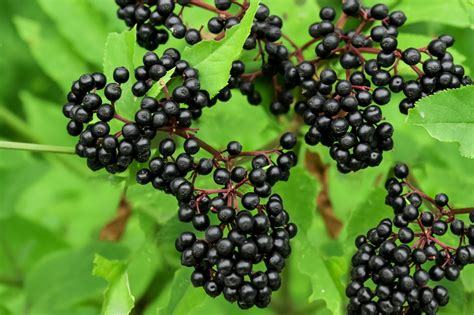
View On WordPress
0 notes